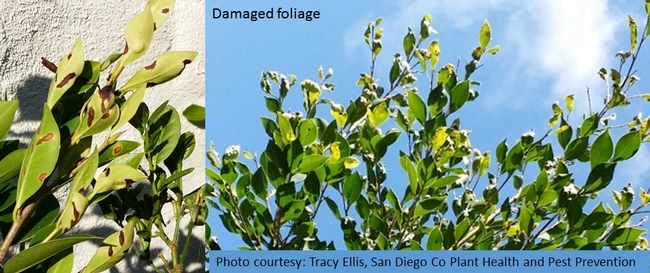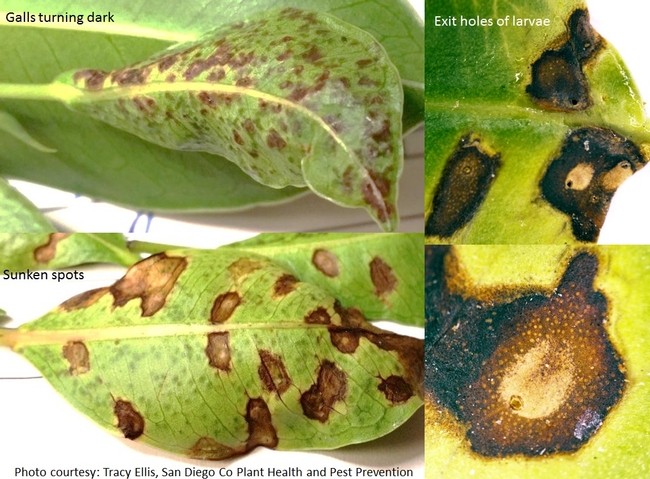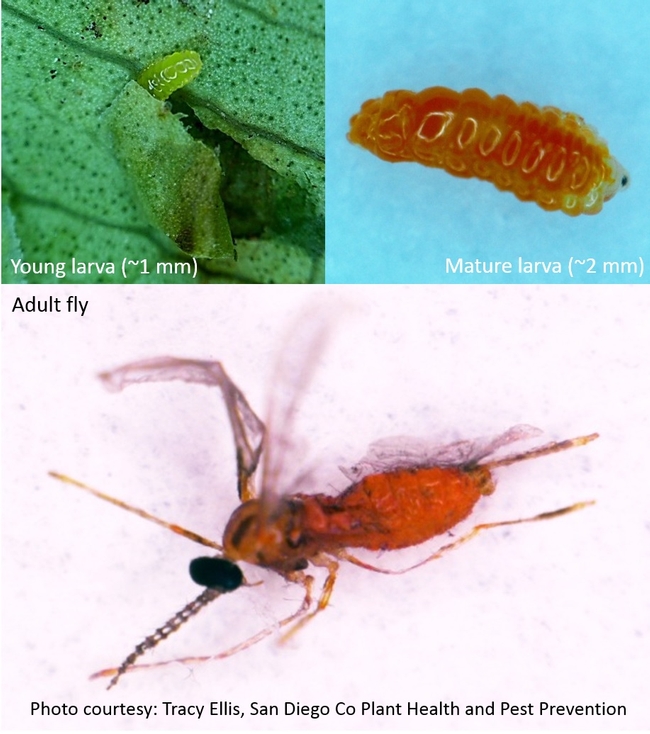Deformed and yellowing foliage of Indian laurel fig infested with the ficus eye-spot midge. Photo: Tracy Ellis.
San Diego County entomologist, Tracy Ellis recently reported the occurrence of a small gall midge in Rancho Santa Fe and La Jolla. Established populations of the ficus eye-spot midge, Horidiplosis ficifolii Harris & de Goffau 2003 (Diptera: Cecidomyiidae) were found in Indian laurel fig (Ficus microcarpa var. nitida) in late 2014. Early last year, another exotic pest, weeping fig thrips (Gynaikothrips uzeli) was found infesting weeping fig (F. benjamina).
Origin and Distribution: Eye-spot midge is native to South East Asia. It was first described from the infestations in weeping fig imported from Taiwan to the Netherlands which later moved to UK. Galls collected in UK and larvae and adults reared in Denmark and the Netherlands were used to describe the pest. Eye-spot midge was later reported in Italy in 2007, USA (Florida) in 2008, and the Czech Republic in 2010.
Host range: It appears to be a primary pest of ornamental figs hence the specific name ficicolii which means 'of fig leaves'. In California, Florida and the Czech Republic, eye-spot midge was found on the Indian laurel fig, in Denmark, UK, and the Netherlands on the weeping fig, and in Italy on a host referred to as ornamental fig.
Damage: Larvae form galls on young leaves. Galls are irregularly shaped and about 4 mm in diameter. When larvae exit the galls for pupation, galls collapse and become dark brown, sunken spots that could be mistaken for leaf spots caused by bacterial or fungal diseases. Circular exit holes of 1-2 mm diameter can be seen on older galls. Heavy infestations could lead to leaf fall.
Mature galls turning into dark, sunken spots. Round holes formed by larvae exiting the galls. Photo: Tracy Ellis.
Biology: Information on eggs is lacking, but they are probably deposited on foliage. Young larvae are translucent and about 1 mm long. They make galls and develop individually inside each gall. Mature larvae are bright orange and up to 2 mm long. Mature larva exits the galls to pupae in the soil or other substrates. Adults are small midges with brownish orange bodies and are weak fliers. Wings do not have any markings and are 1.6 mm long in males and 2 mm in females. Life cycle is completed in about one month at 20oC or 68oF.
Ficus eye-spot midge life stages. Photo: Tracy Ellis.
Management: There are no specific management options reported in any literature except for the removal and destruction of the infested foliage.
What to do: If you suspect ficus eye-spot midge infestations, please inform your local Ag Commissioner or University of California Cooperative Extension office.
http://ucanr.edu/articlefeedback
References
Beránek J. and I. Šafránková I. 2010. First Record of Horidiplosis ficifolii Harris 2003 (Diptera: Cecidomyiidae) in the Czech Republic. Plant Protect. Sci. 46: 189–191.
Caldwell. D. 2012. Ficus trees under attack! https://palmbeachcountyextension.files.wordpress.com/2012/01/ficus-trees-under-attack.pdf
Harris K.M. and L.J.W. De Goffau. 2003. Horidiplosis ficifolii, a new species of gall midge (Diptera: Cecidomyiidae) damaging ornamental fig plants, Ficus benjamina L. Tijdschr. Ent. 146: 301–306.
Steck G.J. and S. Krueger. 2008. An ornamental fig pest, Horidiplosis ficifolii Harris (Diptera: Cecidomyiidae), genus and species new to Florida and North America. http://www.freshfromflorida.com/Divisions-Offices/Plant-Industry/Plant-Industry-Publications/Pest-Alerts/Pest-Alerts-An-Ornamental-Fig-Pest-Horidiplosis-Ficifolii-Harris-Diptera-Cecidomyiidae
Suma P., A. Russo A. and S. Longo. 2007. Horidiplosis ficifolii (Diptera Cecidomyiidae) infestante su Ficus ornamentali in Sicilia. In: Proceeding XXI Congresso nazionale italiano di Entomologia, Catania 10–15 Giugno: 230.
Taxonomic description on Fauna Europaea http://www.faunaeur.org/full_results.php?id=303211
van der Gaag, D. J., E. Dijkstra, W. Lammers, A. Meijer, and E. J. Scholte. 2006. Pest risk analysis: Horidiplosis ficifolii Harris. https://www.nvwa.nl/txmpub/files/?p_file_id=2000933



